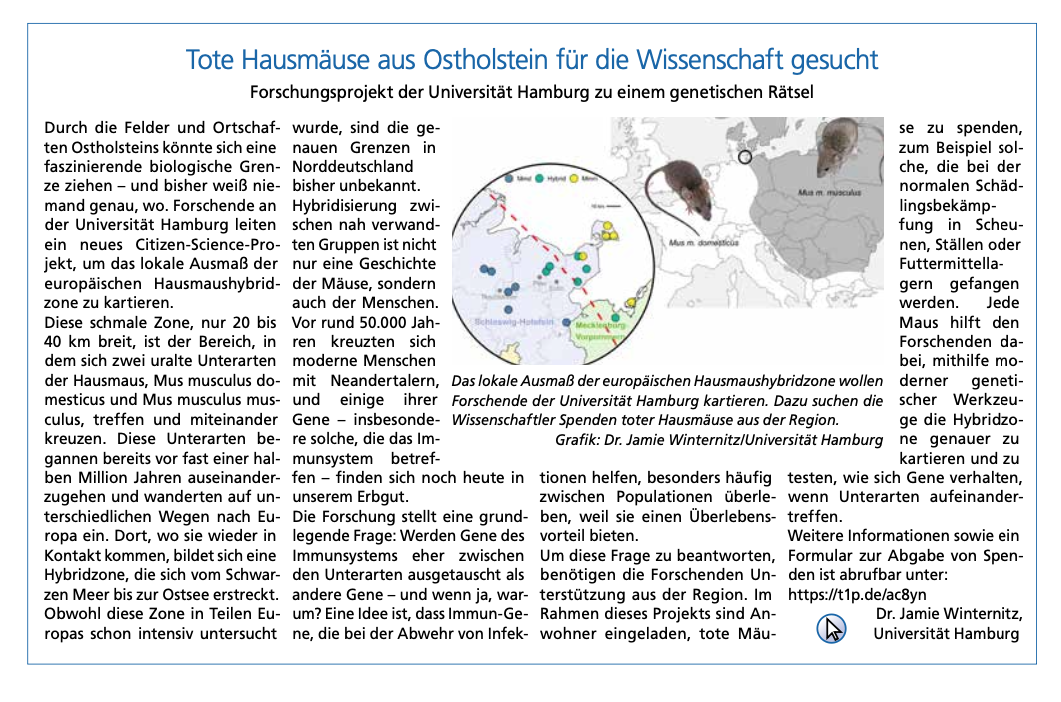Host-parasite interactions
An article in the Schleswig-Holstein Bauernblatt (Farmer’s Monthly Newspaper) describing the project and requesting donations of dead mice, this project uses Citizen Science to map the location of the hybrid zone in Schleswig-Holstein.
Adaptive immune introgression
Hybridization—when different species or populations mix and exchange genes—is more common in nature than we once thought. One way this happens is through introgression, the transfer of genes from one species to another over generations. Scientists believe that genes related to the immune system, which help organisms fight off infections, may move between species more easily than other genes because they provide a survival advantage. Among these, genes from the major histocompatibility complex (MHC) are particularly important, but we still don’t fully understand why their movement between species is beneficial.
This project aims to uncover whether immune system genes, in particular MHC genes, are more likely to transfer between species in a natural population of hybrid mice. To do this, we analyze a combination of biological traits, infection data, and genetic information using advanced sequencing and immune system profiling. Specifically, we investigate whether immune genes are transferred more often than other genes, whether MHC genes are particularly prone to this transfer, and whether this movement actually benefits the mice. By studying this process across a large geographic area with three independent locations, we hope to better understand how immune gene transfer shapes evolution and long-term survival in hybrid populations.
If you live in Schleswig-Holstein, Germany, or just want to learn more, please see our House Mouse Hybrid Zone Project website.
Altitude effects on immune system investment
High-elevation environments pose extreme physiological challenges—lower oxygen levels, colder temperatures, and increased UV radiation all make energy conservation critical for survival. While mammals have evolved remarkable adaptations to cope with these stressors, how such environments shape immune system function remains an open question.
The immune system is among the most energetically demanding life-history traits, requiring substantial resources to maintain and activate. As such, high-altitude conditions may favor immune strategies that minimize energetic costs—for instance, by selecting for immune tolerance rather than resistance to pathogens.
In collaboration with Dr. Alexey Yanchukov and colleagues at Bülent Ecevit University (Turkey), we investigate these questions using Turkish blind mole-rats (Nannospalax xanthodon) and their parasites as a non-model system. This work explores how extreme environments drive evolutionary trade-offs in immune function and contributes to our broader understanding of energy allocation and immune adaptation in the wild.
Selected Publications
Solak HM, Yanchukov A, Ayanoğlu IC, Çolak F, Matur F, Sözen M, Winternitz JC. 2020. Altitudinal effects on innate immune response of a subterranean rodent. Zoological Science 37: 1-11. https://doi.org/10.2108/zs190067
Host-pathogen transcriptomic associations in common buzzards
As part of our research on the evolution of immunity, we examine how behavioral and ecological factors shape parasite exposure and immune responses in wild populations. In collaboration with Dr. Nayden Chakarov and Prof. Oliver Krüger (Bielefeld University, Germany), we study common buzzard chicks to understand how niche choice (e.g., nest location), niche construction (e.g., the addition of greenery to nests), and color morphs influence ectoparasite and blood parasite loads. We also investigate whether different color morphs exhibit distinct transcriptomic responses to infection, and how host and parasite gene expression profiles correlate with parasite load. This integrated approach helps reveal how ecological behaviors and host genotype contribute to the evolution of immune defense strategies in natural populations.
Selected Publications
Winternitz J, Chakarov N, Rinaud T, Ottensmann M, Krüger O. 2023. High functional allelic diversity and copy number in both MHC classes in the common buzzard. BMC Ecology and Evolution 23, 24. https://doi.org/10.1186/s12862-023-02135-9
Ottensmann M, Wiegmann A, Krüger O, Rinaud T, Strube C, Winternitz J, Chakarov N. 2025. Surviving in a changing world: weather and juvenile condition matter for a long-lived avian predator, but blood parasites do not appear to. Oikos e11072. https://doi.org/10.1002/oik.11072



